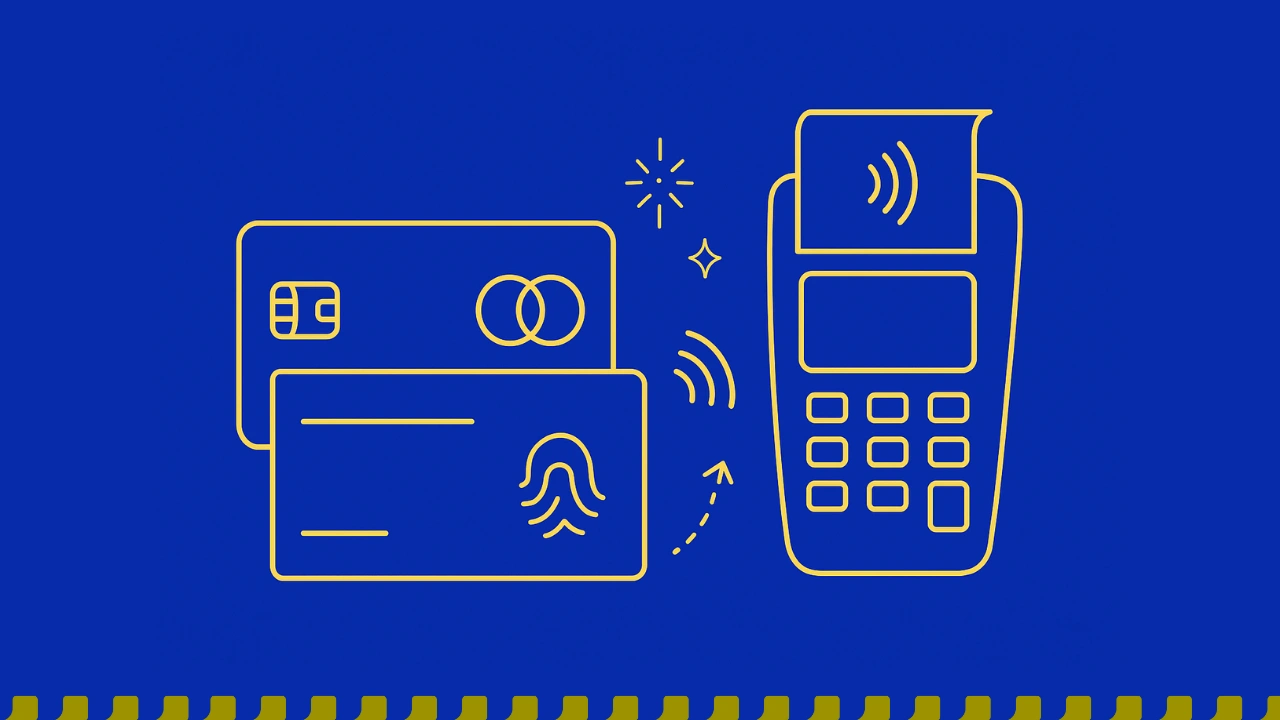Contactless debit and credit cards are cards that emit electromagnetic waves that can be read by contactless payment terminals when placed near them.
Since the COVID-19 lockdown, businesses have massively switched payment methods to contactless payment methods.
Due to its pattern of operation, contactless payments online are gaining acceptance across several businesses.
eCommerce businesses and software businesses, selling digital products, as well as other brick-and-mortar shops, account for over 52% of American establishments that use contactless payments.
Looking at the appearance of contactless debit/credit cards, they resemble normal credit and debit cards. They both have metal chips on the plastic cards or metal cards.
The distinctive feature is that contactless cards usually have a Wi-Fi symbol at the back of the card, and they work with NFC and RFID.
Suppose you need clarification about how contactless cards work, and your safety when you do transactions with your contactless debit and credit cards.
This article will address your queries, and it will also educate you on some other topics that concern contactless cards.

What are Contactless Cards?
Contactless cards are simply debit or credit cards equipped with Near Field Communication (NFC) technology. This allows you to make payments by tapping the card on a compatible reader instead of swiping or inserting it.
Here’s a breakdown of their key features:
- Tap and go: No more fumbling with cash or swiping cards. Simply hold your card near the reader for a quick and seamless transaction.
- Speed: Payments are completed in seconds, significantly reducing checkout times.
- Convenience: Enjoy a more streamlined shopping experience, especially at busy stores or public transportation.
- Security: NFC uses secure encryption, ensuring your card information is protected during transactions.
How Do Contactless Cards Work?
Contactless cards have revolutionized payments, offering speed, convenience, and a touch of bringing the future closer.
But how do these seemingly simple taps transmit your information and secure your hard-earned cash?
Just from the name, contactless payments need no physical touch, swipe, or PIN to confirm their transactions.
Let’s get to the workings of contactless debit and credit cards.
Learn how to set up contactless payments for businesses here.
The Role of NFC Technology
Near Field Communication (NFC) chips are a major component of contactless cards. constantly broadcasting a low-powered radio signal.
When you bring your card within a few inches of a compatible reader, its fields interweave, creating a secure communication channel.
No physical contact, and no friction on the POS device. Just invisible radio waves doing their thing.
The NFC chip transmits encrypted payment information to the reader, including the card number, expiry date, and tokenized data (replacing sensitive information).
The reader relays the information to the payment network for authorization.
The reader relays the information to the payment network for authorization. Once approved, the transaction is completed, and the funds are transferred securely.
Tap to Pay or Tap ‘n’ Go Function
If you want to use your contactless debit/credit card, all you need to do is hold your card close (a few inches from the reader) to the contactless card reader for a few seconds.
Once the transaction is successful, you’ll hear a beep or see the light indicator.
Note that there are transaction limits for contactless transactions. The limits vary, so it depends on your card issuer.
In case you are going beyond your limit, you may need to use your PIN or fingerprint authentication.
Benefits and Risks of Contactless Cards
Like many other innovations, contactless cards have their benefits and risks. With benefits ranging from sleek and speedy payment methods to ease of secured transactions, contactless cards have come to stay.
Despite the benefits, contactless debit cards can be risky. If you hold your contactless debit card closer to any contactless payment card reader can make you pay for what you did not buy.
Benefits of Contactless Cards
- Faster checkout times: Contactless transactions are lightning quick, significantly reducing checkout lines and boosting your overall shopping experience.
- Reduced risk of fraud due to NFC chip: Unlike older magnetic stripe cards, contactless cards utilize embedded chips that generate unique codes for every transaction, making them significantly harder to counterfeit.
- Data encryption and tokenization: Your sensitive payment information isn’t transmitted in plain text. Instead, data encryption and tokenization scramble your details, creating a secure tunnel for information flow and safeguarding your financial data.
- Reduced contact with public places: In a post-pandemic world, they’re a convenient and efficient alternative to traditional methods. It helps you minimize contact while enjoying a smoother checkout experience.
Disadvantages of Using Contactless Cards
- Limited transaction amounts in some regions: To mitigate potential losses, some regions impose lower limits on contactless transactions compared to traditional methods. Be aware of these limitations to avoid unexpected interruptions.
- Accidental payments due to proximity: The convenience of “tap to pay” comes with a potential downside. Accidental payments can occur if your card gets too close to a reader, like in a crowded bus or pocket. Consider using card sleeves or wallets with RFID-blocking technology for added peace of mind.
- Skimming and data theft risks (mitigation strategies): While rare, skimming devices can attempt to steal data in crowded areas. Stay vigilant, choose reputable merchants, and avoid tapping into suspicious locations.
Additionally, keeping your software updated and using contactless cards with strong security features can further minimize these risks.
Knowing the risks and benefits of using contactless cards is an attempt to help you weigh your options and make a decision on whether you use them.
In the same vein, you’ll need to assess your individual needs and risk tolerance before you decide.
Breaking it Down
The future of payments is here, and it’s waving goodbye to cash and long swipes. Contactless debit and credit cards, powered by RFID and NFC technology, offer a faster, safer, and cleaner way to pay.
Simply tap or hover your card near the familiar symbol of four curved lines at checkout, and the magic happens. No more fumbling for bills or handing over germ-ridden cards.
Your bank account and the payment terminal connect in seconds, completing the transaction with lightning speed.
Forget the concerns of skimming or hygiene risks. Contactless payments encrypt your data, making them significantly more secure than traditional magnetic stripe cards.
And in a world increasingly focused on health, tapping your way to checkout keeps both you and the vendor safe.
This revolution in convenience is sweeping the globe, with most vendors now proudly displaying the contactless symbol.
So, embrace the tap and step into a smoother, safer, and more hygienic future. Your wallet (and your fingers) will thank you.
Frequently Asked Questions About Contactless Cards
Using contactless credit/debit cards can be confusing and risky. So, it is only normal if you have some questions bothering you about contactless debit cards and contactless credit cards.
Here are answers to some questions that generally raise confusion among existing and prospective contactless card users.
What Technology do Contactless Cards Use?
Contactless cards work with Radio Frequency Identification (RFID) and Near Field Communication (NFC) technologies. They are the ones responsible for the contactless payment transactions
What is The Difference Between Contactless Debit and Credit Cards and Traditional Cards?
Contactless debit and credit cards don’t need any physical contact with the POS machine. Also, Contactless cards work with NFC and RFID.
How Do You Know if a Card is Contactless?
All contactless cards have a Wi-Fi-looking icon, which is not always on the traditional cards. The icon indicates that the card you are carrying can be used for contactless payments.




